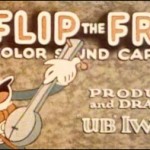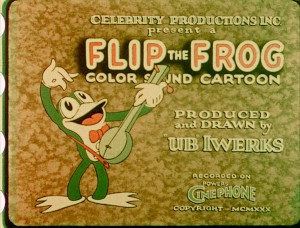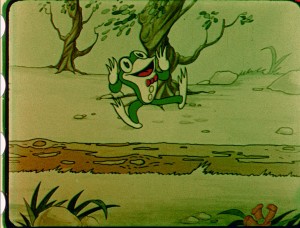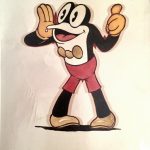Oh, Hoppy Day: The 95th Anniversary of Flip the Frog’s Debut

 The March 1, 1930, issue of the trade paper Exhibitors Herald-World contained an announcement that began: “A new star of the pen and ink is about to make his hop into public notice.”
The March 1, 1930, issue of the trade paper Exhibitors Herald-World contained an announcement that began: “A new star of the pen and ink is about to make his hop into public notice.”
This announcement was referring to Flip the Frog, a brand-new animated character who debuted ninety-five years ago this month. He was created by Ub Iwerks, who, of course, was Walt Disney’s first collaborator, helping to bring both Oswald the Lucky Rabbit and Mickey Mouse to the world.
Ub is also well-known for being loyal to Walt when producer Charles Mintz hired away Disney’s staff in 1928. Ub would stay with Walt for a number of years, but would eventually leave, after the two had a few disputes.
Ub would accept an offer from distributor Pat Powers to open his own Studio, dubbed appropriately, Iwerks Studio. Here, Ub would have a chance to make his own cartoons, which would be produced by Powers’ Celebrity Pictures and distributed by Metro-Goldwyn-Mayer.
 The first of these would feature Iwerks Studio’s new character Flip the Frog (originally named Tony the Frog, until Iwerks changed the name to Flip), in the 1930 cartoon short, entitled Fiddlesticks.
The first of these would feature Iwerks Studio’s new character Flip the Frog (originally named Tony the Frog, until Iwerks changed the name to Flip), in the 1930 cartoon short, entitled Fiddlesticks.
The short opens with Flip hopping and dancing across lily pads in a swamp. After tap dancing atop a turtle shell gets him tossed out of the swamp, he continues his dance on dry land, arriving at an outdoor festivity, where an insect band plays and mice are partying.
Here, he makes his way to the tree stump that serves as a stage and proceeds to perform several dances to the delight of the crowd. Flip then heads over to a piano, where he’s accompanied by a mouse, who bears a striking resemblance to Mickey, and plays the violin. The anthropomorphic piano and piano stool then join the two for a dance. Flip and the mouse go back to playing, and an argument of sorts erupts between Flip and the piano, resulting in Flip punching the piano and knocking out its keys as the short concludes.
 Iwerks, who was an ambitious experimenter for his entire career, produced Fiddlesticks in two-strip color (Walt wouldn’t produce his first color cartoon, Flowers and Trees, until 1932, which was made in the three-strip Technicolor process). Additionally, Iwerks created the design of Flip and did most of the animation in Fiddlesticks himself.
Iwerks, who was an ambitious experimenter for his entire career, produced Fiddlesticks in two-strip color (Walt wouldn’t produce his first color cartoon, Flowers and Trees, until 1932, which was made in the three-strip Technicolor process). Additionally, Iwerks created the design of Flip and did most of the animation in Fiddlesticks himself.
In Fiddlesticks, Iwerks showcases the same talents for expressing personality through animation that were on display in Steamboat Willie, just two years prior. There’s no dialogue in Fiddlesticks (Flip simply “honks” a frog-like croak), but plenty of upbeat, mischievous behavior comes across.
There’s also smooth, energetic animation, particularly in the sequence where Flip concentrates on the piano, purposefully moving his flipper across the keys in perfect synch with the music.
As Iwerks Studio grew, the Flip the Frog cartoons would continue (there were a total of 38 produced), but Flip’s design would shift from amphibious with a bow tie to more human-like. Iwerks was able to lure a tremendous team of talent to his Studio, including musical director Carl Stalling and animators Grim Natwick, Shamus Culhane, and Chuck Jones, (the latter worked there as a cel washer).
 With his last short produced in 1933, Flip the Frog faded in popularity, and a number of the cartoons slipped into the public domain. However, through the years, thanks to diligent work by many authors and historians, as well as Ub’s granddaughter Leslie Iwerks, who has chronicled the filmmakers’ significant contributions, the Flip the Frog cartoon series has received deserved and renewed attention.
With his last short produced in 1933, Flip the Frog faded in popularity, and a number of the cartoons slipped into the public domain. However, through the years, thanks to diligent work by many authors and historians, as well as Ub’s granddaughter Leslie Iwerks, who has chronicled the filmmakers’ significant contributions, the Flip the Frog cartoon series has received deserved and renewed attention.
Ninety-five years after this debut in Fiddlesticks, Flip the Frog may not have generated the star power of other cartoon characters from that same period, but he has definitely earned his rightful place in animation history.
Happy Birthday, Flip!
We highly recommend and refer your to Thunderbean Animation’s Flip The Frog the complete series on blu-ray for more Iwerks information.
